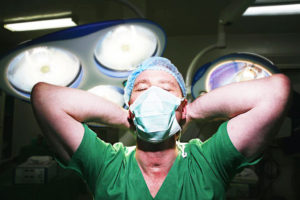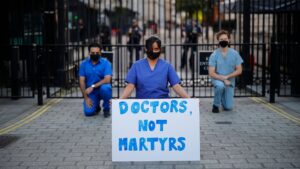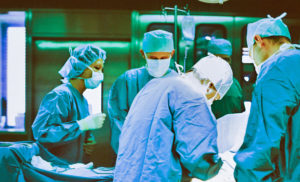When 25-year-old Benedict Peters showed up in A&E in 2022 with chest pain, he was discharged with a diagnosis of gastritis and anxiety. That night, he died from an aortic dissection, a fatal bleed from the largest artery in the body.
Last year, 79-year-old Norman Jopling went to the GP about severe pain in his skull after knocking his head, and was diagnosed with tension headaches. He then suffered a subdural haematoma — a bleed on the brain — and ended up spending months in hospital, unable to speak, walk or move his arms.
And then there’s the case of Emily Chesterton, who made an appointment at her GP practice in October 2022 because her leg was hot and swollen, and she was short of breath. She was sent away with “anxiety” and a “calf sprain” on two separate occasions. The evening of her second visit, she died. She was 30.
These three tragic cases have one thing in common: none of these patients ever saw a doctor. Instead, they were seen by a “physician associate” (PA).
Introduced to the NHS in 2003, PAs were meant to make doctors’ lives easier. They are trained to physically examine patients and take medical histories — and are often the first people to see “undifferentiated” patients (those arriving in either hospitals or primary care without a prior diagnosis). They can therefore play a significant role in determining what treatment a patient gets, even though they are not medically qualified. Where a doctor would have to spend at least 10 years of study and practice to call themselves a GP, a PA undergoes just two years of clinical training.
And herein lies the problem. Even a medical student would likely have recognised that Emily Chesterton was experiencing a pulmonary embolism — which can be easily treated with blood thinners. A recent inquest concluded that she would have survived had she been sent to hospital. The inquest that followed Benedict Peters’s death similarly concluded that it was a “concern” that he was never seen by a doctor.
Worryingly, Emily did not even realise that a doctor had never examined her, as is the case for many patients. A PA could be assisting with your knee replacement, putting you under general anaesthetic, or putting a needle into your spine. They could even be the only “medical professional” that your child sees in A&E. And you may not even realise: six weeks ago, a survey by the British Medical Association (BMA) found that a quarter of respondents mistakenly believed physician associates are doctors.
Even doctors themselves are not immune to this confusion. When I accompanied my father on a hospital appointment recently, what I now know to have been a PA introduced herself as “one of the team”. She was wearing scrubs and a stethoscope with no obvious ID badge explaining her role. It was only when I started asking questions related to my father’s medication, and she seemed unable to answer, that I asked her outright if she was a doctor.
I don’t doubt the rationale for introducing PAs. Doctors are overworking, and a huge chunk of our time is taken up with administrative tasks that you don’t need a medical degree to perform. As a hospital doctor, for instance, you’ll spend at least 30 minutes every morning creating “the list” — a summary of who your patients are, which ward they’re on and which bed they’re in — before hunting down a printer that works so you can distribute it to the entire team. You’ll then have to locate all the notes on your patients — which should be kept around their beds, but tend to be scattered around the ward. Finding them can also take 30 minutes.
PAs could be hugely helpful in keeping paperwork in order, and there are also plenty of clinical tasks they could be trained to perform. Doctors spend untold hours on clunky Windows XP computers requesting blood tests, for example. Or, if we need to cannulate a patient ourselves, searching for all the necessary equipment, it can take 20 minutes. Again, there are so many ways PAs could make this task easier.
And yet, last week, a survey of 18,000 doctors run by the BMA found that the majority believe PAs are adding to their workload, with only 21% saying they are helpful. Many doctors spoke of having to check their PAs’ work.
Because PAs aren’t really qualified to diagnose patients, let alone treat them. The two-year clinical course to become a PA is very much an overview of medicine. It involves as little as two weeks learning about the entirety of, for example, Obstetrics and Gynaecology. To secure a place, you once needed a “science-based” undergraduate degree, but even that requirement has now been dropped completely. Many of the top PA courses have a 100% pass rate, suggesting either exceptional teaching or poor academic standards. It’s hardly surprising that, when the Government announced in November that it planned to increase the number of PAs from 4,000 to 10,000, doctors expressed concerns about patient safety.
It’s also worth pointing out here that a newly qualified PA in London is paid more per hour than a newly qualified doctor. The former can expect a starting salary of £44,000, for 37.5 hours a week. Junior doctors regularly work around 48, for a starting salary of £32,000. The rationale behind this discrepancy was originally that PAs, unlike doctors, were unlikely to ever have “pay progression”, but that was years ago; nowadays, PAs can see their earnings increase with experience. I’ve seen job ads offering £70,000.
I say this not out of resentment, but to demonstrate that increasing the number of physician associates is not, on the face of it, a particularly good use of money. It could also hamper attempts to boost the number of experienced doctors in the NHS.
Since the overhaul in their training 10 years ago, junior doctors have had to “rotate” every four-to-six months until they reach consultant level. Rotations usually require recent med-school graduates to move around the country and switch specialty. PAs, on the other hand, theoretically remain on the team permanently. If a consultant trains a PA to perform a lumbar puncture, or chest drain, or even to be their assistant during a hip replacement, then they will personally benefit from the time they put into training that person. Crucially, they probably won’t have to retrain someone else in a couple of months’ time.
As a result, it’s now not uncommon to find junior doctors doing admin on the ward while PAs are in out-patient clinics or surgical theatres with the consultant. The result, perversely, is PAs getting all the experience that junior doctors need.
The government claims that PAs are merely filling rota gaps because we just don’t have enough doctors. But though it is planning to increase the number PAs, it is doing little to address the bottleneck in opportunities for much better-qualified medical professionals. The NHS’s long-term plan is for consultant anaesthetists to each supervise three Anaesthetic Associates — the equivalent of a PA — simultaneously. Meanwhile, there are nearly 3.5 doctors applying for every anaesthetic training post — a necessary path to consultancy. This bottleneck exists across almost every specialty.
Given these stark facts, how can the NHS — as the chief executive of the General Medical Council has urged it to do — tackle the perception that PAs are replacing doctors? Indeed, how can it deny that replacement was the plan, when official minutes obtained via an FOI state that “there is an ambition to increase PA numbers in the UK and to make sure that maximum value is derived from them as medical role substitutes”?
And how can they explain why some NHS trusts are actually including PAs on senior doctor rotas? I’ve heard reports of PAs being given responsibility for the stroke bleep — the pager that a consultant doctor specialising in strokes is supposed to hold at all times, so that other doctors can contact them urgently when they need advice. This could lead to the absurd scenario of an emergency department consultant being forced to go to a PA for advice.
Then, at the end of last year, the government announced plans for the GMC to regulate PAs. Billed as a “patient safety boost”, this move has criticised for potentially “blurring the lines” between doctors and PAs. Because what patient will be able to tell the difference between Mr John Smith, GMC number 12345 (an orthopaedic surgeon) and Mr John Smith, GMC 23456 (a PA)?
When challenged, it’s common to hear NHS managers justify PAs as bringing “diversity” and “a different perspective” to medical teams. But patients don’t want a different perspective. They want the right treatment. And diversity is only valuable when everyone has received training that qualifies them to undertake the tasks they’re expected to perform.
The evidence that PAs risk harming patients is mounting. A recent FOI request of Leeds Teaching Hospitals has revealed that PAs have ordered over 1,000 treatments that expose patients to ionising radiation, such as X-rays and CT scans, which can only legally be ordered by doctors. And new data from Scotland implicates PAs in a number of “never events”. These are, as the name implies, “wholly preventable” events that should never happen: performing a procedure on the wrong body part, maternal deaths from haemorrhage, incorrectly placing a nasogastric tube.
A price can’t be put on the lives that could potentially be lost if the PA to doctor ratio continues to tip. But the cost of compensation is measurable. Where doctors must pay for their own medical indemnity insurance, which compensates patients harmed by medical negligence, PAs do not; when they make mistakes, it is the NHS itself that pays. Last year, the service spent £2.6 billion compensating victims of negligence; how much more could it have to pay if it succeeds in adding 6,000 PAs to the workforce?
It’s a sign of how desperate the NHS is that it is allowing itself to increasingly depend on physician associates. Doctors are burning out at record rates: we need help. But instead, less qualified members of NHS staff are taking on more and more of our responsibilities, because hiring them is easier than tackling the root causes of the service’s malady. To give patients the care they need, sweeping reform is necessary: of administrative systems, of junior doctors’ rotations, of career ladders. Instead, what we have are physician associates — at best a sticking plaster, and at worst a danger to the NHS.
Disclaimer
Some of the posts we share are controversial and we do not necessarily agree with them in the whole extend. Sometimes we agree with the content or part of it but we do not agree with the narration or language. Nevertheless we find them somehow interesting, valuable and/or informative or we share them, because we strongly believe in freedom of speech, free press and journalism. We strongly encourage you to have a critical approach to all the content, do your own research and analysis to build your own opinion.
We would be glad to have your feedback.
Source: UnHerd Read the original article here: https://unherd.com/






